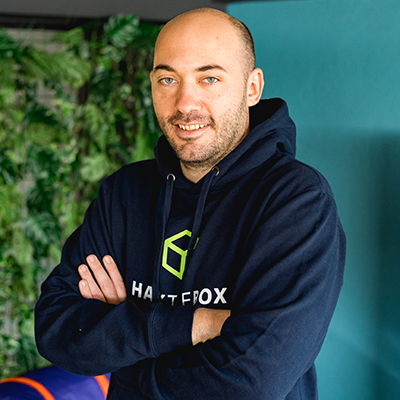Q1. What exactly is Hack The Box's Cyber Performance Center about? How is it different from traditional approaches to cybersecurity training?
Hack The Box’s Cyber Performance Center redefines cyber performance. It provides a platform for business and tech leaders to develop their workforce with plans aligned with organizational objectives, and for teams, professionals, and students to grow.
Hack The Box’s methodology is divided into three pillars inspired by the People, Process, Technology (PPT) framework:
- People: Provide comprehensive career path programs for individuals to develop their skills and knowledge continuously. This includes technical training on tools and technologies, as well as soft skills training on communication, teamwork, and problem-solving.
- Process: Integrate cybersecurity workforce development into existing processes, such as incident response and risk management. Conduct regular tabletop exercises and simulations to practice responding to cyber incidents.
- Technology: Use cutting-edge upskilling courses, labs, and cyber range scenarios equipped with simulated networks, systems, and attack vectors to build hands-on experience in a controlled environment that avoids harming production systems.
- This methodology positively impacts business metrics and cyber resilience, through a concrete cyber performance program. Unlike traditional training methods, Hack The Box provides an all-in-one platform combining ability, business management, and human focus to drive performance, addressing industry challenges like skills gaps, and burnout. The platform features are designed to oversee skills development and analyze potential gaps that could cost real dollars to businesses.
HTB's methodology and leadership position in the market has been recognized in The Forrester Wave Cybersecurity Skills And Training Platforms, Q4 2023.HTB's methodology and leadership position in the market has been recognized in The Forrester Wave: Cybersecurity Skills And Training Platforms, Q4 2023.
Q2. In a recent article, you described university cybersecurity degrees as not always being a good indicator of success for early candidates. Why is that the case? What are some better indicators of success?
Currently, there’s a severe shortage of over four million cybersecurity experts and cyberattacks are on the rise. Given these challenges, recruitment strategies need to adapt and address this gap.
Our research conducted at the beginning of 2024, titled "Securing the future of cybersecurity: From classroom to every career stage" revealed an alarming reality.
Specifically, we surveyed 3,000 professionals across the US and the UK about cyber recruitment, and almost two-thirds (64%) expressed dissatisfaction with current hiring processes, particularly in accurately evaluating candidates’ practical skills. Furthermore, 80% of global professionals attribute the primary entry barriers in the field to favoring degrees over real-world, practical experience.
We have to rethink the way we hire, moving away from a traditional model that focuses solely on university degrees or specific certifications. This doesn’t mean candidates with a university degree aren't worthy; it's that businesses are overlooking a hidden pool of talent who don’t have formal qualifications. I know many very skilled individuals and professionals who don’t have any of the above, but they are very good at what they do. Therefore, we need to reassess how we evaluate candidates in this industry. For example, assessment tests, demos, or practical exercises can effectively measure a candidate’s abilities.
Additionally, instead of only seeking candidates with cybersecurity degrees, recruiters can welcome individuals from all backgrounds. This includes self-taught hackers, those who enhance their skills through online training, Capture The Flag (CTF) competitions, and bug bounty programs. Relying solely on university degrees can sabotage hiring efforts, especially in such a scarce candidate environment.
Q3. What kind of hands-on demos and other events do you have planned for attendees at Black Hat USA 2024? What do you want them to know about your company's approach to cybersecurity training?
On Thursday, August 8, from 12:00-13:30, in the South Pacific G meeting room at Mandalay Bay Convention Center, Level 1, Hack The Box is calling attendees to be among the first cohort to experience our new, enhanced tabletops for executives and global teams to test crisis readiness. You will have the opportunity to assume different roles based on your background and test-drive the powerful capabilities of our new solution in an exclusive scenario focusing on election security. The scenario, called "Operation Secure Code," involves the United States of Luminthia (USL), which is in the midst of a critical election period. Due to heightened political tensions and the importance of maintaining the integrity of the electoral process, the nation faces increased risks of cyber attacks and other forms of interference. HTBSS has been contracted to protect critical systems belonging to various entities within the USL. As a contractor working for HTBSS, a major MSSP based in the USL, you must ensure the confidentiality, integrity, and availability of the systems set up for the USL.
Additionally, CISOs and Tech leaders interested in exploring how Hack The Box can help empower their cyber team's performance with its 360º solutions for recruitment, upskilling, retention, and tracking success, can attend our Happy Hour event on August 7th from 17:00 to 19:00, request a meeting with the HTB team and schedule a demo for Black Hat US 2024. Fill out the following form to secure a slot with one of Hack The Box’s on-site team members: https://resources.hackthebox.com/bh-usa-2024










